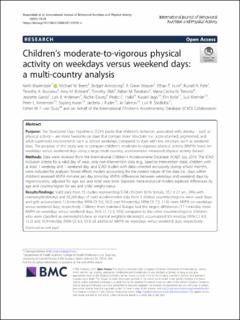| dc.contributor.author | Brazendale, Keith | |
| dc.contributor.author | Beets, Michael W. | |
| dc.contributor.author | Armstrong, Bridget | |
| dc.contributor.author | Weaver, R. Glenn | |
| dc.contributor.author | Hunt, Ethan T. | |
| dc.contributor.author | Pate, Russell R. | |
| dc.contributor.author | Brusseau, Timothy A. | |
| dc.contributor.author | Bohnert, Amy M. | |
| dc.contributor.author | Olds, Timothy | |
| dc.contributor.author | Tassitano, Rafael M. | |
| dc.contributor.author | Tenorio, Maria Cecilia M. | |
| dc.contributor.author | Garcia, Jeanette | |
| dc.contributor.author | Andersen, Lars Bo | |
| dc.contributor.author | Davey, Rachel | |
| dc.contributor.author | Hallal, Pedro C. | |
| dc.contributor.author | Jago, Russell | |
| dc.contributor.author | Kolle, Elin | |
| dc.contributor.author | Kriemler, Susi | |
| dc.contributor.author | Kristensen, Peter L. | |
| dc.contributor.author | Kwon, Soyang | |
| dc.contributor.author | Puder, Jardena J. | |
| dc.contributor.author | Salmon, Jo | |
| dc.contributor.author | Sardinha, Luís B. | |
| dc.contributor.author | van Sluijs, Esther M. F. | |
| dc.date.accessioned | 2021-12-08T12:58:56Z | |
| dc.date.available | 2021-12-08T12:58:56Z | |
| dc.date.created | 2021-06-09T12:13:11Z | |
| dc.date.issued | 2021 | |
| dc.identifier.citation | International Journal of Behavioral Nutrition and Physical Activity. 2021, 18(2021), Artikkel 28. | en_US |
| dc.identifier.issn | 1479-5868 | |
| dc.identifier.uri | https://hdl.handle.net/11250/2833362 | |
| dc.description | This article is licensed under a Creative Commons Attribution 4.0 International License, which permits use, sharing, adaptation, distribution and reproduction in any medium or format, as long as you give appropriate credit to the original author(s) and the source, provide a link to the Creative Commons licence, and indicate if changes were made. The images or other third party material in this article are included in the article's Creative Commons licence, unless indicated otherwise in a credit line to the material. If material is not included in the article's Creative Commons licence and your intended use is not permitted by statutory regulation or exceeds the permitted use, you will need to obtain permission directly from the copyright holder. | en_US |
| dc.description.abstract | Purpose: The Structured Days Hypothesis (SDH) posits that children’s behaviors associated with obesity – such as physical activity – are more favorable on days that contain more ‘structure’ (i.e., a pre-planned, segmented, and adult-supervised environment) such as school weekdays, compared to days with less structure, such as weekend days. The purpose of this study was to compare children’s moderate-to-vigorous physical activity (MVPA) levels on weekdays versus weekend days using a large, multi-country, accelerometer-measured physical activity dataset.
Methods: Data were received from the International Children’s Accelerometer Database (ICAD) July 2019. The ICAD inclusion criteria for a valid day of wear, only non-intervention data (e.g., baseline intervention data), children with at least 1 weekday and 1 weekend day, and ICAD studies with data collected exclusively during school months, were included for analyses. Mixed effects models accounting for the nested nature of the data (i.e., days within children) assessed MVPA minutes per day (min/day MVPA) differences between weekdays and weekend days by region/country, adjusted for age, sex, and total wear time. Separate meta analytical models explored differences by age and country/region for sex and child weight-status.
Results/findings: Valid data from 15 studies representing 5794 children (61% female, 10.7 ± 2.1 yrs., 24% with overweight/obesity) and 35,263 days of valid accelerometer data from 5 distinct countries/regions were used. Boys and girls accumulated 12.6 min/day (95% CI: 9.0, 16.2) and 9.4 min/day (95% CI: 7.2, 11.6) more MVPA on weekdays versus weekend days, respectively. Children from mainland Europe had the largest differences (17.1 min/day more MVPA on weekdays versus weekend days, 95% CI: 15.3, 19.0) compared to the other countries/regions. Children who were classified as overweight/obese or normal weight/underweight accumulated 9.5 min/day (95% CI: 6.9, 12.2) and 10.9 min/day (95% CI: 8.3, 13.5) of additional MVPA on weekdays versus weekend days, respectively.
Conclusions: Children from multiple countries/regions accumulated significantly more MVPA on weekdays versus weekend days during school months. This finding aligns with the SDH and warrants future intervention studies to prioritize less-structured days, such as weekend days, and to consider providing opportunities for all children to access additional opportunities to be active. | en_US |
| dc.language.iso | eng | en_US |
| dc.subject | accelerometer | en_US |
| dc.subject | children | en_US |
| dc.subject | physical activity | en_US |
| dc.subject | structure | en_US |
| dc.subject | weekday | en_US |
| dc.subject | weekend | en_US |
| dc.title | Children's moderate-to-vigorous physical activity on weekdays versus weekend days: A multi-country analysis | en_US |
| dc.type | Peer reviewed | en_US |
| dc.type | Journal article | en_US |
| dc.description.version | publishedVersion | en_US |
| dc.rights.holder | © The Author(s). 2021 | en_US |
| dc.source.pagenumber | 13 | en_US |
| dc.source.volume | 18 | en_US |
| dc.source.journal | International Journal of Behavioral Nutrition and Physical Activity | en_US |
| dc.identifier.doi | 10.1186/s12966-021-01095-x | |
| dc.identifier.cristin | 1914786 | |
| dc.description.localcode | Institutt for idrettsmedisinske fag / Department of Sports Medicine | en_US |
| dc.source.articlenumber | 28 | en_US |
| cristin.ispublished | true | |
| cristin.fulltext | original | |
| cristin.qualitycode | 2 | |
